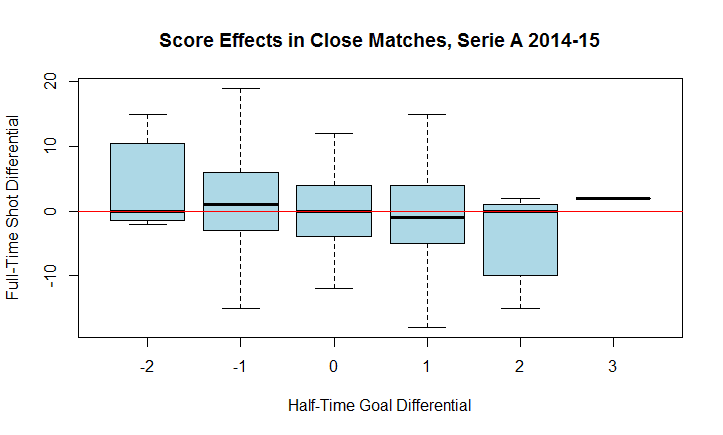Such "score effects" have been attributed to tactics; teams with a narrow lead tend to go into a defensive shell to protect what little they have, while teams trailing by a narrow margin desperately attempt to secure an equalizer by becoming more attacking.
In this post, I examine score effects in 6 top-flight European football leagues this season, English Premier League, La Liga Primera Division, Bundesliga, Seris A, Ligue 1, and of course the Scottish Premiership.
Specifically, I will look at how half-time (HT) score influences full-time (FT) shot differentials in matches that end close. All of the 2014-15 data used in this post were downloaded from football-data.co.uk and analyzed with R.
Let's start with the English Premier League. Note: the thick line in the middle of each box is the median shot differential for teams in that game state at HT.
As you can see, the data follow the expected pattern, teams down 1 goal at HT tend to out-shoot the opposition by FT, and teams in the lead at HT usually end up with negative shot differentials.
This pattern matches the results of previous studies based on more detailed game state data for the Premier League.
From what I can tell, it seems like very little work has been published on score effects outside of the Premier League. So I thought it would be interesting to see if the same pattern holds in other top-flight European leagues.
Below are box plots for La Liga, Bundesliga, Serie A, and Ligue 1.
Remarkably, these charts all show the same pattern as the Premier League; in close games, teams in the lead at HT tend to play more defensively, resulting in negative shot differentials at FT. Conversely, teams down by 1 at HT tend to go on the attack, and end up out-shooting the opposition by FT.
Given this evidence, score effects would appear to be ubiquitous in European football. However, when I examined the data for the Scottish Premiership, I discovered an unexpected pattern.
Unlike the other European leagues, teams up 1 goal at HT in the SPFL typically end up with positive shot differentials at FT. Conversely, SPFL teams down 1 goal at HT typically end up with negative shot differentials.
This pattern holds even if you remove the small number of close matches Celtic have played, and if you analyze home and away teams separately.
So what is going on in Scotland?
It would appear that SPFL teams use different tactics than teams in other European leagues, especially when leading by 1 goal at HT. Instead of going into a defensive shell to hold onto a narrow lead, teams in Scotland typically continue to attack, to try to get a second or third goal.
It wasn't this way last year, as the box plot below illustrates.
Last year, the SPFL followed the typical pattern seen in other European leagues, with teams down 1 goal at HT going on the attack more than teams up by 1 at HT.
Many in Scottish football regard the current season as one of the most competitive and entertaining in recent memory, certainly in the post-Rangers era. Part of that perception may be due to an attacking style of play that is unusual these days in European football.







No comments:
Post a Comment